|
Impact categories, normalisation and weighting in LCA 4. Global warming
Global warming - or "greenhouse effect"/"climate change" - addresses the effect of increasing temperature in the lower atmosphere. The atmosphere is normally heated by incoming radiation from the sun. A part of the radiation is normally reflected by the surface of the Earth but the content of carbon dioxide (CO2) and other "greenhouse" gasses (e.g. methane (CH4), nitrous oxide (N2O), chlorofluorocarbons etc.) in the atmosphere reflects or absorbs the IR-radiation resulting in the greenhouse effect, i.e. an increase of temperature in the lower atmosphere to a level above normal. The possible consequences of the greenhouse effect include an increase of the temperature level leading to melting of the polar ice caps and glaciers in mountain area, resulting in elevated sea levels. The increasing temperature level may also result in regional climate changes.
Figure 4.1 Global warming - energy balance (Trenberth et al. 1996). The complexity of this modelling is high and the difficulty in calibration and verification of the modelling is huge. However, it is considered as a fact that the global temperature has increased during the last century. The specific consequences of global and regional climate changes due to increase of temperature are uncertain. Lately, computer models have been developed, demonstrating increased intensity as well as frequencies of storms, increased number and length of draught. Although the consequences of the climate changes are considered uncertain there seems to be a general international agreement that there will be (a risk of) huge impacts, which should be avoided or at least minimised. This is reflected in international agreements like the Montreal Protocol and the Kyoto Protocol with respect to reduction of relevant substances. 4.1 Substances contributing to the impact categoryThe substances contributing to global warming are defined as substances which at normal temperature and pressure are gases and:
The substances normally considered as contributors to global warming are:
For CO2 it is a special requirement that the emission must represent a net contribution, i.e. it must increase the content of CO2 in the atmosphere beyond that which would be observed if the emission did not take place. Examples of this are burning of fossil fuels and changes in land use, e.g. as a cause of deforestation. Use of biomass (wood, straw, etc.) for energy production does not give a net contribution, because it can be assumed that the materials would degrade under all circumstances. 4.2 Global Warming PotentialIn the original EDIP (Wenzel et al. 1997; Hauschild & Wenzel 1998) and many other LCA methodologies the potential global warming or greenhouse effect is quantified by using global warming potentials (GWP) for substances having the same effect as CO2 in reflection of heat radiation. GWP for greenhouse gases are expressed as CO2-equivalents, (CO2-eq.) i.e. the effects are expressed relatively to the effect of CO2. GWP's are normally based on modelling and are quantified for time horizons of 20, 100 or 500 years for a number of known greenhouse gasses (e.g. CO2, CH4, N2O, CFC's, HCFC's, HFC's and several halogenated hydrocarbons etc.). The emission of greenhouse gasses is regulated by the Kyoto Protocol under the Climate Convention. Global warming potentials for the known greenhouse gasses are developed by the "Intergovernmental Panel on Climatic Change" (IPCC) and they are revised continuously as the models used in the calculations are developed. GWP-values can be found in Hauschild and Wenzel (1998) and the last revision of some of the GWP-values for a number of substances can be found in Schimel et al. (1996). The potential greenhouse effect of a product/process can be estimated by calculating the product of the amount of emitted greenhouse gas per functional unit and the potential for greenhouse effect given in kg CO2-equivalents per kg emitted gas. 4.3 Normalisation reference and weightingfactor for global warming The normalisation references and the weighting factors for global warming are calculated according to the general formula in chapter 1, Introduction. Table 4.1 presents the normalisation references and the weighting factors for global warming in different regions. Table 4.1 Normalisation reference and weighting factors for global warming (Hoffmann 2001; Busch 2001).
Global warming is a global effect and therefore the global normalisation reference is recommended. It is also recommended to use the global weighting factor for the global impacts. 4.4 Example of applying normalisation reference and weighting for global warmingThe normalised global warming potential for the considered product is calculated as follows: where:
where: Calculation of the weighted impact potential for the considered product is done as follows: where:
where: Figure 4.2 illustrates the normalised global warming potentials calculated by applying the global normalisation reference. For impacts that are potentially global, the global normalisation reference combined with the global weighting factor for global warming are recommended. Based on an impact potential for the product in question at 0.29 ton CO2-eq./year the actual normalised and weighted values are 33 mPEW94 and 37 mPETW2004 respectively. Figure 4.2 Normalised (A) and weighted (B) global warming potentials for production of a refrigerator at different localities. Arrows indicate the recommended choices.
4.5 If you would like to know moreYou can read more about the subject in: Busch, N.J. 2005, Calculation of weighting factors. In Stranddorf, H.K., Hoffmann, L. & Schmidt, A. Update on impact categories, normalisation and weighting in LCA. Environmental Project no. 995, Danish EPA, 2005 Hansen, J.H. 1995, Ozonlagsnedbrydende stoffer og HFC - forbrug i 1994. Miljøprojekt nr. 302. København: Miljøstyrelsen. Hauschild, M. & Wenzel, H. 1998, Global warming as a criterion in the environmental assessment of products. In Hauschild M, Wenzel H (eds.). Environmental assessment of products.Volume 2: Scientific background. London: Chapman & Hall. Hoffmann, L. 2005, Global warming. In Stranddorf, H.K., Hoffmann, L. & Schmidt, A. Update on impact categories, normalisation and weighting in LCA. Environmental Project no. 995, Danish EPA, 2005 Trenberth, K.E., Houghton, J.T., Meira Filho, L.G. (1996). The climate system: an overview. Chapter 1 in Houghton, J.T., Meira Filho, L.G., Callander, B.A., Harris, N., Kattenberg, A. & Maskell, K. (eds.) Climate change 1995 - The science of climate change. Cambridge: Cambridge University Press. Wenzel, H., Hauschild, M. & Alting, L. 1997, Environmental Assessment of Products.Volume 1 - Methodology,Tools and Case Studies in Product Development. First edition. Chapman & Hall, London. http://www.unep.org; http://www.unep.ch
|




